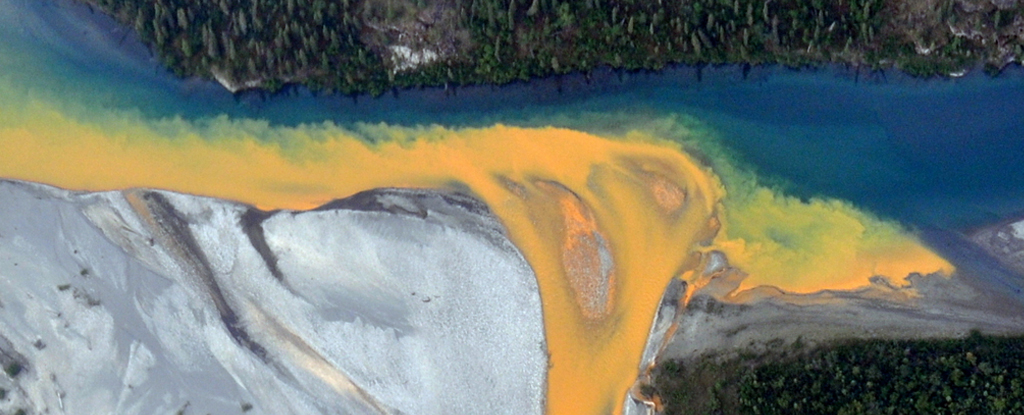Alaska
Alaska's Pristine Waterways Are Turning a Shocking Orange

Some of Alaska’s clear, icy blue waterways are turning a startling rust orange – so intense it’s visible from Earth’s orbit.
“The stained rivers are so big we can see them from space,” says University of California (UC) Davis environmental toxicologist Brett Poulin. “These have to be stained a lot to pick them up from space.”
After first noticing the problem in 2018 from river banks and fly-overs, National Park Service ecologist Jon O’Donnell, Poulin and their colleagues used satellite imagery and public reports to identify over 75 remote streams recently tainted this unusual orange color, across almost 1,000 kilometers (1,610 miles) of Alaska’s Brooks Range.
“There are certain sites that look almost like a milky orange juice,” describes O’Donnell. “Those orange streams can be problematic both in terms of being toxic but might also prevent migration of fish to spawning areas.”
Samples from some of these waterways collected between June and September 2022 contained high concentrations of iron and other toxic metals, including zinc, copper, nickel, and lead, when compared to nearby healthy streams. In some cases, these pollutants ramped up the water’s acidity from the usual pH of 8 to 2.3.
The results look similar to acidic mining runoff, Poulin says, yet there are no mines anywhere near these locations.
Instead, by examining satellite imagery from 1985 to 2022, O’Donnell, Poulin and their colleagues determined this strange phenomenon has only been occurring during the last decade, and it coincides with warmer weather and increased snowfall.
“Our working hypothesis is that the thawing of permafrost soil is allowing water to infiltrate deeper and interact with minerals that have been locked away for thousands of years,” explains Poulin.
frameborder=”0″ allow=”accelerometer; autoplay; clipboard-write; encrypted-media; gyroscope; picture-in-picture; web-share” referrerpolicy=”strict-origin-when-cross-origin” allowfullscreen>
The Arctic is warming about four times faster than the rest of our planet. That extra heat melts frozen ground, increases microbial activity, and causes ‘shrubification’ – with those new roots further disturbing the soil. Together these processes are exposing the previously protected minerals to weathering and displacing them into watersheds.
“Climate change and associated permafrost thaw appear to be the primary drivers of stream impairment,” the researchers conclude. “Stream discoloration was associated with dramatic declines in macroinvertebrate diversity and fish abundance.”
This change in water chemistry due to acid rock drainage threatens not only wildlife but local people who rely on these streams for drinking water and subsistence fishing.
O’Donnell and the team are continuing their investigation in the hopes of understanding the broader ecological impacts for the region and working out when and where the toxic orange taint will strike again.
“There’s a lot of implications,” explains O’Donnell. “As the climate continues to warm, we would expect permafrost to continue to thaw and so wherever there are these types of minerals, there’s potential for streams to be turning orange and becoming degraded in terms of water quality.”
Their research was published in Communications Earth & Environment.

Alaska
Heat spreads across Alaska with no widespread rain in sight

ANCHORAGE, Alaska (KTUU) – Tuesday was the fifth day in a row with above-average temperatures in Anchorage, and the 10th consecutive day without any measurable rainfall. This warm and dry trend will continue through the end of June, and likely into the first week of July.
High pressure is centered over the state. With the upper-level winds forced north, most of Alaska will stay storm-free.
The same cannot be said for the Aleutians or across the Bering Sea. An area of low pressure is spreading north, bringing high winds, rain, and a high surf to the northern Kuskokwim Bay coast. This area should be prepared for water levels to rise three to six feet above normal high tide. Wind gusts of 45 to 50 mph are also likely.
The Aleutians will also stay cool Wednesday, but high temperatures will climb back to the upper 60s and low 70s across Southcentral, mid- to upper 60s across Southeast, to the 80s across the Interior, and even to the 60s on the Slope.
Anchorage has already reached 75 degrees or above three times this month. We’ve only seen three days over 75 degrees in June six times in recorded history. The overall average temperature for June is only about half a degree above what is normal but is about 2 degrees above June to date of 2023. This month’s rainfall is also significantly lower than what most of Anchorage experienced last June, which brought 17 days with measurable precipitation, while this year, we’ve seen just four days with rain.
The number of active wildfires in the state is up to 222 as of Tuesday evening, and 22 of those are new in the past 24 hours. Fortunately, lighting activity was lower on Tuesday, with fewer than 1,000 strikes recorded. More than 5,000 lightning strikes were recorded in Alaska on Monday, and more than 6,000 were tallied on Sunday.
With high fire danger continuing, use extra caution to keep from adding any additional human-caused fires. Burn permits are suspended in the Mat-Su and Interior. Open fires are prohibited in Anchorage.
Copyright 2024 KTUU. All rights reserved.
Alaska
Report identifies opportunities restoring access to SE Alaska fisheries – The Cordova Times

A new report compiled by the Alaska Sustainable Fisheries Trust (ASFT) in Sitka finds that Southeast Alaska communities are losing access to fisheries, but also identifies opportunities for implementing new ways to restore such access for the region.
“Based on what we heard from the dozens of community members who participated in our survey, it is clear that Southeast’s communities, particularly Indigenous communities, are losing access to fisheries and their future access remains uncertain,” said Linda Behnken, ASFT board president. “However, it is also clear that we have some real opportunities when it comes to designing and implementing new tools to help restore this access and ensure that local needs are being factored into larger discussions and decisions concerning Southeast’s economy.”
The report, released June 18, compiles findings of a regional survey ASFT distributed to area residents this spring in collaboration with the Sustainable Southeast Partnership (SSP) — proposing ways to address issues. The report was funded by the Southeast Conference through the U.S. Department of Agriculture’s Southeast Alaska Sustainability Strategy initiative.
ASFT said the goal is to assist local communities by providing data and information for future dialogues and community development planning, increasing awareness and encouraging more funds for fishery access-related projects. Participating communities included Angoon, Craig, Haines, Kake, Ketchikan, Klawock, Klukwan, Juneau, Sitka, Wrangell, and Yakutat.
Responses from these communities universally identified the fisheries as a crucial element of Southeast Alaska’s culture and economy moving forward. Respondents expressed concern about their ability to access and have a sustainable livelihood from local fisheries through traditional harvesting, commercial or recreational fishing.
Respondents’ key concerns included the changing climate and environment of Southeast Alaska and a sense of unpredictability for the future of marine resources. They expressed a lack of confidence that current scientific approaches to fishery management will be adequate in light of significant changes affecting the region and its resources due to climate change.

The report also discussed existing systems of governance that challenge access to fishery resources, challenges with limited access management at the state and federal levels and loss of community infrastructure such as processors, fish buyers, cold storage, marine services and/or transportation often initiated with the trend in outmigration of fishery access in remote communities.
Many participating area residents said the utmost priority is protection and perpetuation of a traditional way of life, with commercial fishing considered secondary, as a tool to bridge the traditional and cash economies.
They discussed the rapid growth of tourism in Southeast Alaska as something feeding competition and tensions between local-commercial and traditional-use harvesters and non-local harvesters in the sportfish sector.
The report included recommendations for building more equitable and accessible fisheries in Southeast Alaska, including incorporating climate change variability and unpredictability into fishery management tools to facilitate fishery access and to ensure that other industries, including tourism and mariculture, do not further limit fishery access.
Recommendations also included establishing regional entities to hold quota/permits (such as regional Community Quota Entities and regional fisheries trusts) and more investment in community infrastructure.
Behnken said that ASFT was grateful to everyone who shared their thoughts on this complex topic.
“We hope that this report will uplift their voices and be a chance for the public, policy makers, and others to better understand some of the challenges that many Southeast residents are facing so that we can collectively find solutions and build a resilient and vibrant future for Southeast’s fisheries and communities,” she said.

Alaska
Hot and dry conditions lead to increasing wildfire danger across Alaska

ANCHORAGE, Alaska (KTUU) – Summer weather continues to build in across the state, as a ridge is greatly influencing the weather across Mainland Alaska. Temperatures have been warming into the 70s and 80s through the Interior, while Southcentral has seen highs in the 60s and the 70s. This stretch of warm weather will remain through the week, accompanied by possibly thunderstorm development.
While hot and dry conditions have been building, the Aleutians are dealing with wet and breezy weather. This comes as a low near the Aleutians continues to lift to the north. Expect widespread rain through parts of this region, with the heaviest rain near the Pribilof Islands. Winds will gust anywhere from 30 to 65 mph. As the rain pushes to the northeast, it will run into ridging and quickly taper off into Wednesday. Some light rain showers look possible through parts of Southwest Alaska tomorrow morning, before the rain comes to an end.
Outside of the Aleutians and areas with thunderstorm formation, Alaska will remain on the drier side this week. While the ridge isn’t strong enough to cap thunderstorm development, it will prevent its widespread activity. It’s likely isolated to scattered storms will persist through the Interior and in Southcentral Alaska. A quick reminder that burn permits have been suspended in the Mat-Su Valley and Fairbanks due to the hot and dry conditions.
Any storms across Southcentral today will primarily impact western parts of the Matanuska Valley, the foothills of the Talkeetna Mountains and into the Copper River Basin. Storm motion will be to the north, so Anchorage and surrounding locations will largely stay dry. A rogue thunderstorm can’t be ruled out for the Kenai, but any precipitation will come in the form of spotty to isolated morning showers.
This hot and dry weather pattern continues through the end of June. Here in Southcentral, the weekend is once again shaping up to warm into the 70s.
Have a wonderful and safe Tuesday!
Copyright 2024 KTUU. All rights reserved.
-

 News1 week ago
News1 week agoIt's easy to believe young voters could back Trump at young conservative conference
-

 World1 week ago
World1 week agoSwiss summit demands 'territorial integrity' of Ukraine
-

 World1 week ago
World1 week agoProtesters in Brussels march against right-wing ideology
-

 News1 week ago
News1 week agoA fast-moving wildfire spreads north of Los Angeles, forcing evacuations
-

 World1 week ago
World1 week agoAl-Qaeda affiliate claims responsibility for June attack in Burkina Faso
-

 Movie Reviews1 week ago
Movie Reviews1 week agoShort Film Review: Willow and Wu (2024) by Kathy Meng
-

 News1 week ago
News1 week agoMass shooting at Rochester Hills splash pad: Everything we know
-

 Movie Reviews1 week ago
Movie Reviews1 week agoMovie Review: Top 5 Movies to Watch This Father's Day June 16, 2024 –

/cdn.vox-cdn.com/uploads/chorus_asset/file/25505687/VERNE_Exterior1.jpg)












